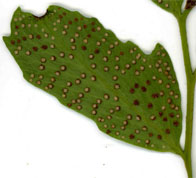|
Hardy Fern Home C. falcatum resources All Ferns � Dryopteridaceae �� Cyrtomium
�Other Genera
|
| Cyrtomium falcatum | ||
Asiatic holly fern | ||
|
Etymology
Falcatum is the word for sickle-shaped.
Description
Rhizome: erect, massive, with several fronds at apex, scales ovate to oblong-lanceolate, acuminate, dark brown, paler near margin, papery, usually about 1.
Frond: 60 cm high by 25 cm wide, evergreen, monomorphic, blade/stipe ratio: 3:2. Stipe: scales orange-brown, ovate, vascular bundles: 4 or more, in an arc. Blade: 1-pinnate, oblong-lanceolate, leathery, glossy, bright green, glabrous above, wooly scales below early, then falling. Pinnae: 4 to 12 pair, to 12 cm, sometimes eared at the base on the upward edge, pointed at the tip,apical pinna not larger; margins often undulate or coarsely and irregularly dentate; veins netted. Sori: round, dispersed on the lower surface of pinnae throughout or sometimes confined to the upper pinnae, indusium: peltate, brown, sometimes blackish center, persistent, central, sporangia: brown. Culture
Habitat: sunny lowlands, often along sea coast.
Distribution: Japan, Korea, China (eastern and southern parts), Vietnam, India.
Hardy to -15�C, USDA Zone 7.
Synonyms
Polypodium falcatum Linnaeus Aspidium falcatum (L.) Sw. Polystichum falcatum (L.) Diels |
|
|
Notes
Photos It is difficult to believe all of the photos are of the same species.
Photos It is difficult to believe all of the photos are of the same species.


